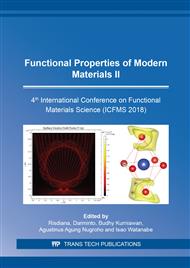[1]
O. Graria, A. Et Taouil, L. Dhouibi, C.C. Buron, F. Lallemand, Multilayered polypyrrole–SiO2 composite coatings for functionalization of stainless steel: Characterization and corrosion protection behavior, Progress in Organic Coatings 88 (2015), 48–53.
DOI: 10.1016/j.porgcoat.2015.06.019
Google Scholar
[2]
I.A. Rahman and V. Padavettan, Synthesis of Silica Nanoparticles by Sol-Gel: Size-Dependent Properties, Surface Modification, and Applications in Silica-Polymer Nanocomposites-A Review, Journal of Nanomaterials 2012 (2012), Article ID 132424, 15 pages.
DOI: 10.1155/2012/132424
Google Scholar
[3]
A.F. Irwati and M. Zainuri, Effect of Heat Treatment Temperature on Hydrofobic Composite Coatings PDMS / SiO2 phases cristobalite silica, ITS Journal of Science and Arts 5 (2016) 1-5.
Google Scholar
[4]
B, Karthick and R. Maheshwari, Lotus-Inspired Nanotechnology Applications, Reson 13 (2008) 1141-1145.
DOI: 10.1007/s12045-008-0113-y
Google Scholar
[5]
Munasir, A. Sulton, Triwikantoro, M. Zainuri, Darminto, Synthesis of Silica Nanopowder from Slopeng Natural Sands via Alkalifussion Route, AIP Conf. Proc. 1555 (2013) 28.
DOI: 10.1063/1.4820986
Google Scholar
[6]
X. Gao and L. Jiang,Water-repellent legs of water striders, Nature 432 (2004) 36-37.
DOI: 10.1038/432036a
Google Scholar
[7]
Y. Xu, C. Peng, C. Xin, J. Wu, Preparation of silica antireflective films for solar energy application, Mater. Lett. 94 (2013) 89-91.
DOI: 10.1016/j.matlet.2012.12.013
Google Scholar
[8]
S. Cai, Q. Xue, B. Xia, J. Yang, H. Lv, H, Yan, B. Jiang, Hydrophobic–oleophobic antireflective film with excellent optical property prepared by simple sol–gel route, Mater. Lett.156 (2015) 14-16.
DOI: 10.1016/j.matlet.2015.04.110
Google Scholar
[9]
V.G. Parale, D.B. Mahadik, M.S. Kavale, S. A. Mahadik , A. Venkateswara Rao, Steven Mullens, Sol–gel preparation of PTMS modified hydrophobic and transparent silica coatings, J. Porous Mater. 20 (4) (2012) 733-739.
DOI: 10.1007/s10934-012-9648-0
Google Scholar
[10]
V. Purcar, I. Stamatin, O. Cinteza, C. Petcu, V. Raditoiu, M. Ghiurea, T. Miclaus, A. Andronie, Fabrication of hydrophobic and antireflective coatings based on hybrid silica films by sol–gel process, Surf. Coatings Technol. 206 (2012) 4449–4454.
DOI: 10.1016/j.surfcoat.2012.04.094
Google Scholar
[11]
K. Lee, S. Lyu, S. Lee, Y.S. Kim, W. Hwang, Characteristics and self-cleaning effect of the transparent super-hydrophobic film having nano fibers array structures, Appl. Surf. Sci. 256 (22) (2010) 6729–6735.
DOI: 10.1016/j.apsusc.2010.04.081
Google Scholar
[12]
H.M. Kim, S. Sohn, J.S. Ahn, Transparent and super-hydrophobic properties of PTFE films coated on glass substrate using RF-magnetron sputtering and Cat-CVD methods, Surf. Coat. Technol. 228 (2013) S389–S392.
DOI: 10.1016/j.surfcoat.2012.05.085
Google Scholar
[13]
B.Wang, Y. Zhang, L. Shi, J. Li and Z. Guo, Advances in the theory of superhydrophobic surfaces, Journal of Materials Chemistry 22 (2012) 20112-20127.
Google Scholar
[14]
Cassie, A. B. D. dan S. Baxter, Wettability of porous surfaces, Transactions of the Faraday Society 40 (1944) 546-551.
DOI: 10.1039/tf9444000546
Google Scholar
[15]
P.Roach, N.J. Shirtcliffe and M.I. Newton, Progess in superhydrophobic surface development, SoftMatter 4 (2008) 224-240.
DOI: 10.1039/b712575p
Google Scholar
[16]
R.N. Wenzel, Resistance of Solid Surfaces to Wetting by Water, Industrial & Engineering Chemistry 28 (1936) 988-994.
DOI: 10.1021/ie50320a024
Google Scholar
[17]
S. Wang, Y. Li, X. Fei, M. Sun, C. Zhang, Q. Li, Preparation of a durable superhydrophobic membrane by electrospinning poly (vinylidene fluoride) (PVDF) mixed with epoxy-siloxane modified SiO2 nanoparticles: a possible route to superhydrophobic surfaces with low water sliding angle and high water contact angle, J. Colloid Interface Sci. 359 (2011) 380–388.
DOI: 10.1016/j.jcis.2011.04.004
Google Scholar
[18]
J. Bravo, L. Zhai, Z. Wu, R.E. Cohen, M.F. Rubner, Transparent superhydrophobic films based on silica nanoparticles, Langmuir 23 (2007) 7293-7298.
DOI: 10.1021/la070159q
Google Scholar
[19]
H. Ogihara, J. Xie, J. Okagaki, T. Saji, Simple method for preparing superhydrophobic paper: spray-deposited hydrophobic silica nanoparticle coatings exhibit high water-repellency and transparency, Langmuir 28 (2012) 4605-4608.
DOI: 10.1021/la204492q
Google Scholar


